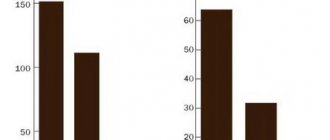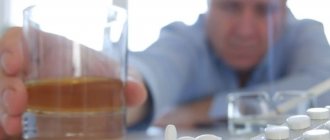Publications in the media
(Coffeinum-natrii benzoas)
Synonyms.
Composition and release form. Powder, tablets of 0.075, 0.1 and 0.2 g; 10% and 20% solutions in ampoules of 1 and 2 ml and in syringe tubes of 1 ml.
Indications. Increased mental and physical performance; infectious and other diseases accompanied by inhibition of the functions of the central nervous system and cardiovascular system; poisoning with narcotic and other drugs that depress the central nervous system; drowsiness; hypotension; enuresis; migraine.
Pharmachologic effect. Caffeine sodium benzoate is a psychostimulant - a purine derivative. The neurochemical mechanism of action of drugs in this group is their ability to compete with adenosine for “purine” or adenosine receptors, which contributes to the development of a psychostimulating effect. Sodium caffeine benzoate in large doses inhibits phosphodiesterase, which leads to the accumulation of intracellular c-AMP, which enhances glycogenolysis, metabolic processes in muscle tissue and the central nervous system. The drug stimulates all parts of the central nervous system. Compared to amphetamine stimulants, the effect on the central nervous system is more “mild”. Sodium caffeine benzoate has a positive inotropic and chronotropic effect, causing an increase in the frequency and strength of heart contractions, and increases cardiac output.
In high doses, caffeine causes severe tachycardia, and in highly sensitive patients arrhythmias (ventricular extrasystoles) may develop. The action of caffeine has central and peripheral components regarding vascular tone. By stimulating the vasomotor center, caffeine increases vascular tone, and with a direct effect on smooth muscles, it reduces vascular tone. Caffeine increases systemic vascular resistance, which leads to increased blood pressure. These effects are associated with the drug's blockade of adenosine vasodilation and activation of the sympathetic division of the autonomic nervous system. The drug has a stimulating effect on skeletal muscles, possibly by inducing the release of acetylcholine, increasing the strength of contractions and relieving muscle fatigue. Caffeine sodium benzoate stimulates the secretion of hydrochloric acid by parietal marks and the activation of pepsin. The drug has a mild diuretic effect by increasing renal blood flow and glomerular filtration rate and reducing the reabsorption of sodium and water in the proximal renal tubules. Inhibits uterine contractility, increases the concentration of catecholamines in the blood plasma and urine, causes a short-term increase in plasma levels due to stimulation of glycogenolysis and lipolysis. The drug stimulates the respiratory center, increasing the breathing rate. In high doses, caffeine has analeptic properties.
Pharmacokinetics. The drug is easily absorbed from the gastrointestinal tract into the blood when taken orally or parenterally. Absorption of methylxanthines occurs mainly due to their lipophilicity rather than water solubility. Caffeine sodium benzoate is quickly distributed in all tissues of the body; easily penetrates the placental and blood-brain barriers; the volume of distribution in adults ranges from 0.4 to 0.6 l/kg. Binds to plasma proteins by 25-36%. The peak concentration of the drug in the blood plasma is observed 50-75 minutes after oral administration. Therapeutic concentrations in blood plasma are 5-25 mcg/ml (25.8-128.8 μmol/l). The drug is metabolized in the liver. About 80% of its dose is converted to paraxanthine (1,7-dimethylxanthine), about 10% to theobromine (3,7-dimethylxanthine), and about 4% to theophylline (1,3-dimethylxanthine). These compounds are further metabolized by demethylation to first form monomethylxanthines and ultimately methylated uric acid derivatives. T 1/2 averages 3-7 hours. The drug is excreted mainly in the form of metabolites by the kidneys, 1-2% is excreted unchanged.
Side effects. Dizziness; cardiopalmus; irritability, nervousness or severe nervous agitation; tremor; sleep disturbance; diarrhea, nausea, vomiting.
Contraindications. Increased excitability, insomnia; severe hypertension and atherosclerosis, organic diseases of the cardiovascular system; glaucoma.
Adverse reactions when interacting with other drugs. When taken concomitantly in large doses with MAO inhibitors, including procarbazine and selegiline, caffeine sodium benzoate may cause the development of dangerous cardiac arrhythmias or severe hypertension as a result of increased sympathomimetic effects of caffeine; small doses of caffeine-sodium benzoate may lead to a slight increase in blood pressure and tachycardia. With simultaneous use of the drug with other central nervous system stimulants, the development of hyperstimulation of the central nervous system, up to the development of arrhythmias and seizures, is possible. Concomitant use of barbiturates (phenobarbital) and caffeine sodium benzoate may increase caffeine metabolism due to barbiturate-induced induction of liver microsomal enzymes, leading to increased elimination of caffeine sodium benzoate. Cimetidine and OK reduce the metabolism of caffeine in the liver, which leads to an increase in its concentration in the blood and increased side effects of the latter.
Information for the patient. The drug is used orally in tablets of 0.1-0.2 g 2-3 times a day 30-40 minutes before meals. Do not take the drug immediately before bed. Extended-release capsules should be swallowed whole without breaking, crushing or chewing. It is not recommended to drink caffeine sodium benzoate with milk, as it is bound by 30% milk protein, and the release of caffeine from this binding is very slow. Smoking accelerates the metabolism of caffeine-sodium benzoate and reduces its therapeutic effects. Drinking large quantities of coffee with a high caffeine content in the drink (60 mg of caffeine per 100 g of drink), tea (50 mg per 100 g of drink), cola, cocoa and chocolate with preparations containing caffeine or caffeine-sodium benzoate may lead to tachycardia , increased breathing and dizziness. Closely monitor for signs indicating the occurrence of possible side effects, especially such as stimulation of the central nervous system and irritation of the gastrointestinal mucosa, dysfunction of the cardiovascular system.
Missed dose: Take the missed dose as soon as possible; do not take it at all if there is no time left before the next dose; do not take double doses.
Caffeine anhydrous: what is it?
Caffeine is naturally found in plants such as coffee beans and tea, as well as cocoa beans, which are the raw material for cocoa and chocolate production. Through specific laboratory processes, including filtering water and other chemical components from caffeine, so-called caffeine anhydrous is obtained in the form of a white crystalline powder that is more concentrated. Therefore, it has a stronger effect than its "regular" form.
Caffeine anhydrous is one of the most popular and widely used exercise enhancers. Used by athletes involved in endurance sports.
For those suffering from cardiovascular diseases, consult your doctor.
Caffeine increases blood pressure for 3-4 hours, this is a proven fact. However, with regular consumption this effect is not so noticeable. In healthy people who do not exceed the permitted 400 mg, the risk of developing cardiovascular diseases does not increase. But for people with high blood pressure or those who have already suffered cardiovascular disease, in other words, for patients who are contraindicated for stimulants, the effects of caffeine intake are not so obvious. A moderate amount will not harm them, but it is better to consult a doctor about specific doses.
So, people with high blood pressure or a history of cardiovascular disease are not advised to regularly drink caffeine-containing drinks. There should be no harm from small portions, but it is better to seek advice.
How much do you need to drink to reach your caffeine limit?
To answer this question, you need to know how much caffeine is in each cup/can/bottle you drink. This information is contained in Figure 1, but for those who find it difficult to concentrate without caffeine, as well as for adherents of a mono-diet (like starting the day with coffee from McDonald's, they won't take anything else caffeinated in their mouth) there is also Figure 2.
Rice. 2 How many and what drinks can you drink so as not to exceed the daily caffeine limit of 400 mg.
Pregnant and lactating women - handle with caution
The European Food Safety Authority recommends that lactating and pregnant women, as well as those planning a pregnancy, limit their daily caffeine intake to 200 mg. Some experts allow 300 mg/day, however, according to some reports, caffeine causes nausea in pregnant women and, much worse, the risk of miscarriage.
There are very few clinical studies on the effects of caffeine on pregnant and lactating women, and in such a situation it is wiser to limit the consumption of the alkaloid. In pregnant women, the time required to remove caffeine from the body increases by more than three times, so caffeine can accumulate: what you drink in the evening is added to what was stored in the morning, and the total dose of the substance circulating in the blood turns out to be higher than calculated.
So, pregnant and lactating women should not exceed the daily dose of 200 mg, although they are allowed 300 mg.
Tips for consuming caffeine anhydrous
Before physical training, in order to increase performance, it is recommended to take anhydrous caffeine in a dose of about 3-6 mg per 1 kg of body weight .
It is important to start taking the drug at the lower end of this range and gradually increase the amount. This will allow you to determine the minimum dose that should be taken to obtain the expected effect of increasing endurance during training.
It should be remembered that doses above 6 mg per 1 kg of body weight do not provide any additional benefits from taking supplements, and can only cause side effects and pose a direct threat to life in case of caffeine overdose.
Given the timing, it's best to take caffeine about an hour before your scheduled workout or competition.
Benefits of Using Caffeine Anhydrous
The main benefits of using caffeine anhydrous are:
- easier adjustment of the correct dose compared to the consumption of brewed drinks, such as regular coffee
- best availability as powder, capsules, chewing gum or gel
- improving results achieved in sports.
The most important rule when taking caffeine anhydrous powder is to follow the dosage based on body weight!
The mechanism of action of caffeine and its effect on the body
Whether we are dealing with caffeine found in natural ingredients or caffeine anhydrous, the mechanism of action is the same.
Caffeine is quickly absorbed into the gastrointestinal tract and moves through cell membranes into tissues with the same efficiency. An increased concentration of caffeine in the blood is observed within 15-45 minutes after its consumption. The maximum level increase occurs after an hour. Over the next 3-6 hours, the amount of caffeine in the bloodstream decreases by 50-75%.
Basic properties of caffeine anhydrous:
- eliminating drowsiness, reducing fatigue, as it affects the central nervous system
- the effect of increasing the ability to exercise, generating energy for working muscles
- improved endurance
Children and adolescents - it is better to abstain
There is clearly insufficient data on safe doses of caffeine for children and adolescents. According to European experts, 3 mg/kg of body weight per day will not harm young consumers. In Canada, a dose of no more than 2.5 mg/kg/day is considered safe. In accordance with these standards, children, depending on age, are allowed to:
- 4-6 years - 45 mg/day
- 7-9 years - 62.5 mg/day
- 10-12 years - 85 mg/day.
Not everyone agrees with this opinion. Thus, in 2013, a group of distinguished American doctors sent a letter to the US Food and Drug Administration calling for a ban on the sale of caffeinated drinks in schools. Scientists note that energy drinks are reliably correlated with adverse health effects in children, adolescents and young adults.
So the safe level of caffeine for children and adolescents has been determined, but some medical organizations are calling for more thorough research into this problem, and until data is collected, the less caffeine a child consumes, the better.
What dose is too much?
There is no exact answer to this question - a safe dose of caffeine depends on your health condition. Some people drink strong coffee all day long without any harmful consequences, while for others, just a single cup causes their blood pressure to rise, their sleep to be disturbed, headaches, and nerves. The nervousness caused by caffeine can be alleviated by the amino acid L-theanine, which is found in green tea leaves. Interestingly, similar symptoms are observed in people with caffeine withdrawal. They also yawn, complain of fatigue, runny nose, muscle stiffness, and find it difficult to concentrate. Unfortunately, caffeine cannot be considered a completely safe product.







